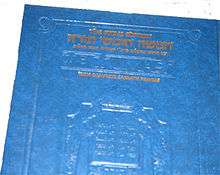Chumash (Judaism)
| Part of a series on |
| Judaism |
|---|
   |
|
Other religions
|
|
Related topics |
|
The Hebrew term Chumash (also Ḥumash; Hebrew: חומש, pronounced [χuˈmaʃ] or pronounced [ħuˈmaʃ] or Yiddish: pronounced [ˈχʊməʃ]) is a Torah in printed form (i.e. codex) as opposed to a Torah scroll. The word comes from the Hebrew word for five, ḥamesh (חמש). A more formal term is Ḥamishah Ḥumshei Torah, "five fifths of Torah". It is a Hebrew name for the Five Books of Moses, also known by the Latinised Greek term Pentateuch in common printed editions.[1]
Origin of the term

The word "ḥumash" may be a vowel alteration of ḥomesh, meaning "one-fifth", alluding to any one of the five books: as the Hebrew חומש has no vowel signs, it could be read either way. It could also be regarded as a back-formed singular of ḥumashim/ḥumshei (which is in fact the plural of ḥomesh).
In early scribal practice there was a distinction between a Sefer Torah, containing the entire Pentateuch on a parchment scroll, and a copy of one of the five books on its own, which was generally bound in codex form, like a modern book, and had a lesser degree of sanctity. The term ḥomesh strictly applies to one of these. Thus, ḥomesh B'reshit strictly means "the Genesis fifth", but was misread as ḥumash, B'reshit and interpreted as meaning "The Pentateuch: Genesis", as if "ḥumash" was the name of the book and "Bereshit" the name of one of its parts. Compare the misunderstanding of "Tur" to mean the entirety of the Arba'ah Turim.
In the legal codes, such as Maimonides' Mishneh Torah, it is laid down that any copy of the Pentateuch which does not comply with the strict rules for a Sefer Torah, for example because it is not a parchment scroll or contains vowel signs, has only the same sanctity as a copy of an individual book (ḥomesh). In this way, the word ḥomesh (or ḥumash) came to have the extended sense of any copy of the Pentateuch other than a Sefer Torah.
Usage
The word ḥumash generally only refers to "book" bound editions of the Pentateuch, whereas the "scroll" form is called a sefer Torah ("book [of the] Torah").
In modern Jewish practice:
- A printed ḥumash usually sets out the Hebrew text of the Torah with vowel points and cantillation marks, separated into its 54 constituent weekly Torah portions (parashiyyot), together with the haftarah for each portion and, often, translations and notes.[2]
- A ḥumash-Rashi also contains the Targum of Onkelos and the commentary of Rashi, and may or may not have a vernacular translation of the text.
- A Tikkun soferim or Tiqqun Qore'im sets out, in parallel columns, the unvocalized text of the Pentateuch as it would appear in a Torah scroll and the normal printed text as it appears in a Chumash; it sometimes includes haftarot and the five megillot. It exists as an aid for Torah scribes and for those preparing to read from the Sefer Torah in the synagogue.
- A multi-volume set in Hebrew only, often but not always including the entire Tanakh with masoretic notes (sometimes), Targumim and several classical commentaries, is referred to as Mikraot Gedolot "Great Scriptures."
Various publications
- see also Jewish English Bible translations
- Gutnik Chumash with Onkelos, Rashi and commentaries of the Lubavitcher Rebbe
- The Pentateuch and Haftorahs, London 1937, known as the "Hertz Chumash", containing the commentary of former British Chief Rabbi Joseph Hertz
- Soncino Chumash, (1st of the 14 volume Soncino Books of the Bible series) ed. Abraham Cohen, containing notes summarizing the traditional commentaries (Mikraot Gedolot).
- Torah and the Haftarot, translation by Philip Birnbaum (Hebrew Publishing Company, 1983. ISBN 0-88484-456-0)
- Etz Hayim Humash (Published by the Jewish Publication Society of America ISBN 0-8276-0712-1): associated with Conservative movement
- The Torah: A Modern Commentary Revised Edition. W. Gunther Plaut, ed. New York: Union for Reform Judaism, 2006: associated with American Reform movement
References
- ↑ Zaklikowski, Dovid. "What does Chumash mean?". Chabad.org. Retrieved 2016-12-03.
- ↑ Levenson, Alan T. (2011). The Making of the Modern Jewish Bible: How Scholars in Germany, Israel, and America Transformed an Ancient Text. Rowman & Littlefield Publishers. pp. 181–183. ISBN 978-1-4422-0516-1.
External links
- Chumash on Judaism 101
- Chumash (5 Books Of Moses) on Judaism.com